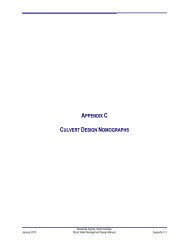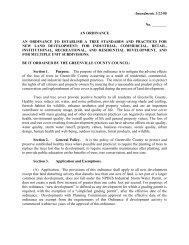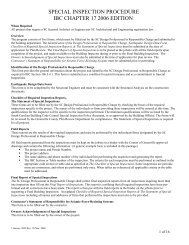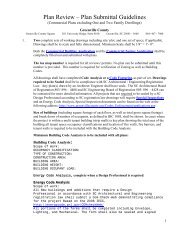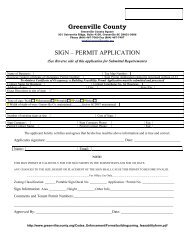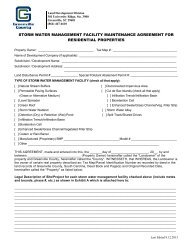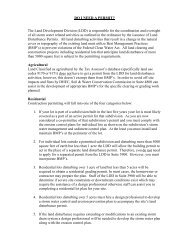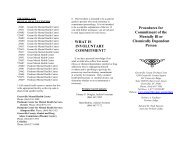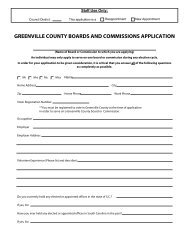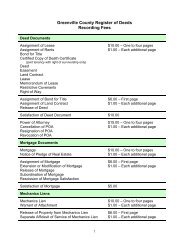Entire Design Manual - Greenville County
Entire Design Manual - Greenville County
Entire Design Manual - Greenville County
Create successful ePaper yourself
Turn your PDF publications into a flip-book with our unique Google optimized e-Paper software.
1.5.2. Best Site <strong>Design</strong> Practices and Site Planning Process<br />
The first step in addressing storm water management begins in the site planning and design stage of the<br />
development project. By implementing Best Site <strong>Design</strong> Practices during the site planning process, the<br />
amount of runoff and pollutants generated from a site can be reduced by minimizing the amount of<br />
impervious area and utilizing natural on-site treatments. The minimizing of adverse storm water runoff<br />
impacts by the use of Best Site <strong>Design</strong> Practices and site planning should be a major consideration for a<br />
design professional.<br />
The reduction of runoff volumes and storm water pollutants reduces the total number and size of storm<br />
water management controls that must be implemented under the guidelines set forth in this <strong>Design</strong><br />
<strong>Manual</strong>. Best Site <strong>Design</strong> Practices reduce the amount of total post-development impervious areas and<br />
maintains natural characteristics of the pre-development site conditions. Therefore, the post-development<br />
curve number and time of concentrations are maintained more closely to those of the pre-development<br />
condition, thereby reducing the overall hydrologic and hydraulic impact of the development.<br />
Implementing Best Site <strong>Design</strong> Practices can reduce the Storm Water Utility Fee by decreasing the total<br />
impervious area of a development site.<br />
Maintaining Site Resources and Natural Undisturbed Areas<br />
Conservation of site resources and natural undisturbed areas helps to reduce the post development runoff<br />
volume and provide areas for natural storm water management. Some natural site resources that should be<br />
maintained include, but are not limited to:<br />
Natural drainage ways;<br />
Vegetated buffer areas along natural waterways;<br />
Floodplains;<br />
Areas of undisturbed vegetation;<br />
Low areas within the site terrain;<br />
Natural forested infiltration areas; and,<br />
Wetlands.<br />
Land Disturbance Limits<br />
In steeply sloping areas with 15% or greater slopes, limit the amount of land disturbance to 5 acres at<br />
one time; non-active areas must be stabilized prior to disturbing additional areas; and,<br />
In areas with slopes less 15%, limit land disturbances to 17 acres or less at one time without applying<br />
stabilization practices.<br />
Lower Impact Site Layout Techniques<br />
Lower impact site layout techniques involve identifying and analyzing the location and configuration of<br />
structures on the site to be developed. Where applicable, the following options that create lower impacts<br />
layouts should be used:<br />
Fit the design layout to follow the natural contours of the site to minimize clearing and grading and<br />
preserve natural drainage ways;<br />
Limit the amount of clearing and grading by identifying the smallest possible area on the site that<br />
would require land disturbance;<br />
Place development areas on the least sensitive areas of the site; and,<br />
<strong>Greenville</strong> <strong>County</strong>, South Carolina<br />
January 2013 Storm Water Management <strong>Design</strong> <strong>Manual</strong> 1-4



